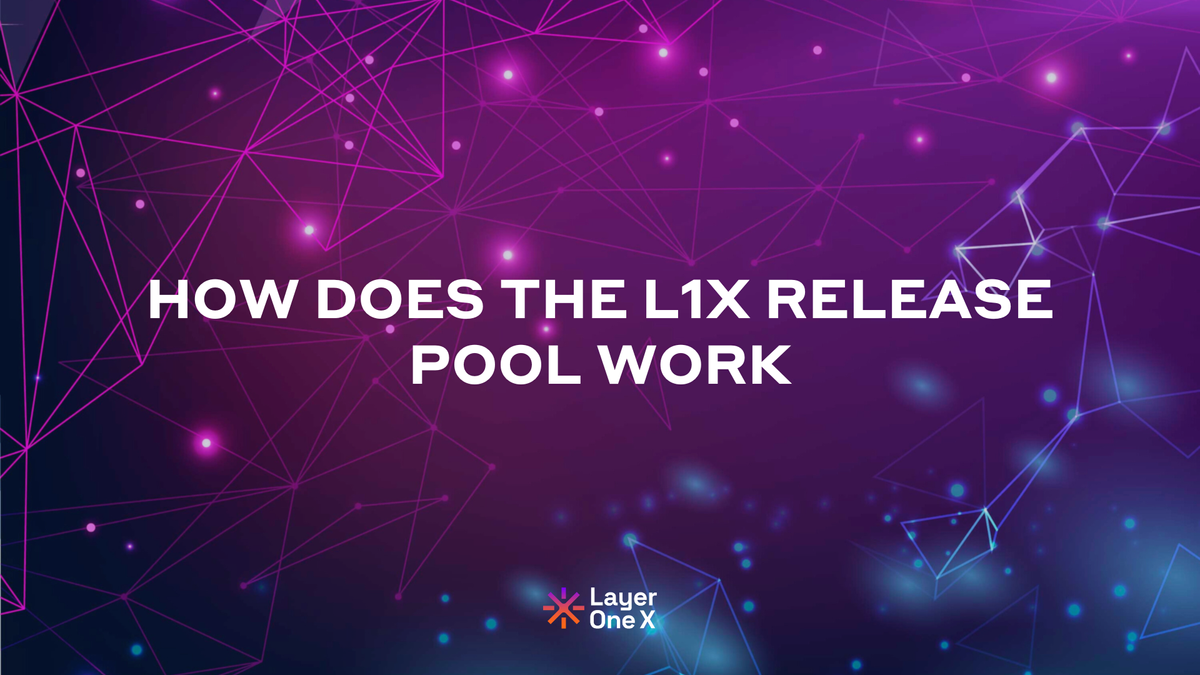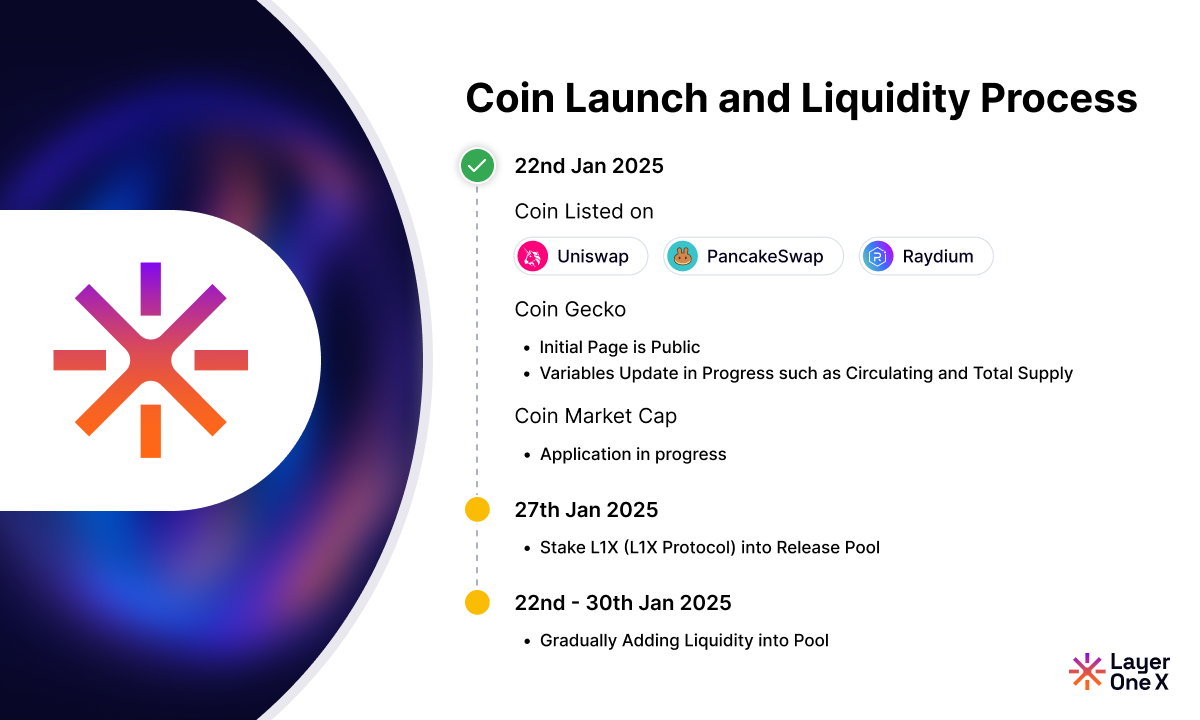The Release Pool is critical in Layer One X’s (L1X) tokenomics, functioning as a key mechanism to ensure price stability and mitigate the risk of sudden market dumps. This strategic feature is designed to regulate the automated sale of coins, aligning with L1X’s broader commitment to fostering a sustainable and healthy token ecosystem.
How the Release Pool Works
L1X coin holders can stake their coins in the Release Staking Pool (Decentralised Contract), which operates with sophisticated performance algorithms. The algorithms interact seamlessly with the trading pools where L1X is listed, ensuring controlled and strategic token sales. The system is designed to prevent large-scale sell-offs from any token distribution pool, thereby maintaining market stability and preventing price volatility. For 2025, this strategy is aimed at preserving a healthy and sustainable L1X coin price, while simultaneously providing coin holders with the flexibility to sell their tokens in a steady and controlled manner, achieving optimal market conditions for all stakeholders.
Key highlights of the Release Pool mechanism
• Automated Sales: Tokens are released systematically to maintain liquidity without overwhelming the market.
• Controlled Supply: The gradual release prevents oversupply, ensuring a healthy balance between supply and demand.
• Dynamic Adjustments: The system can adapt to market conditions, further reducing the likelihood of price volatility.
Anti-Dump Strategy
The Release Pool is central to L1X’s anti-dump strategy, specifically designed to protect the token’s value and promote long-term growth. By automating and controlling token sales, the pool minimizes the potential for large-scale sell-offs by stakeholders or malicious actors, which could destabilize the market.
Benefits of the Release Pool
- Market Stability: Protects the token price from drastic fluctuations caused by high-volume token releases.
- Investor Confidence: Demonstrates a commitment to sustainable market practices, building trust among investors and stakeholders.
- Strategic Liquidity Management: Ensures sufficient liquidity in decentralized exchanges (DEXs) while avoiding excess supply.
By incorporating the Release Pool into its tokenomics model, L1X takes a proactive approach to address the challenges of token price stability. This mechanism not only supports L1Xs long-term vision but also enhances the appeal to both investors and users by fostering a fair and balanced ecosystem.
Prioritization of Coin Holders (Investors)
The Coin release strategy includes prioritization of different categories of L1X coin holders:
- Category A (Rights Issue & XPerks): High-priority investors, including term-sheet/public/private sale buyers.
- Category B (Node Operators, Developers and Performance Airdrops): Medium-priority stakeholders.
- Category C (Non-XPerks & Bonus Holders): Low-priority participants, often rewarded at a $0 base.
Key Objectives
- Stabilize the L1X price and encourage organic growth on DEX platforms.
- Gradually grow liquidity pools to attract external participants.
- Shift control over Coin circulation and pricing to a more transparent, decentralized environment.
Coin Release Plan: Categories and User Weightage
This document outlines a phased Coin release strategy for Categories A, B, and C based on priority weightage and user allocation mechanisms. It ensures fairness by combining category-wise prioritization with user-level weightage and equal distribution.
Categories and Phased Release Plan
The Coin release plan is divided into three categories with priority-based sequential releases. The release phases will ensure high-priority categories have access to liquidity first, while gradually including lower-priority categories over time.
Category Definitions
|
Category |
Description |
Priority Level |
|
Category A |
Presale to DeX, Rights Issue, XPerks and CeX Buyers |
High |
|
Category B |
Node Operators, Developers and Performance Airdrops |
Medium |
|
Category C |
Non-XPerks (Bonus Coins) |
Low |
Phased Release Plan
The phased release ensures sequential and proportionate Coin distribution over time:
|
Phase |
Time Period |
Category A (%) |
Category B (%) / Category C (%) |
|
Phase 1 |
0–2 Months |
100% |
0% / 0% |
|
Phase 2 |
3–12 Months |
70% |
30% / 0% |
|
Phase 3 |
12+ Months |
70% |
20% / 10% |
User Weightage and Allocation
Within each category, coins are allocated to users using a combination of weightage-based allocation (based on individual holdings) and equal distribution.
Equations for User Allocation
1. Weighted Allocation:
Weighted Allocation (User i) = (User i's Coins / Total Coins in Category) × Weighted Pool
2. Equal Distribution Allocation:
Equal Distribution (User i) = Equal Pool / Total Number of Users
3. Final Allocation:
Final Allocation (User i) = Weighted Allocation (User i) + Equal Distribution (User i)
Example Calculation
Assume the following scenario for Category A in Phase 2:
- Total Coins: 1,000
- Weighted Pool: 25% (250 coins)
- Equal Pool: 75% (750 coins)
Calculations (Example):
• Total Coins in Pool Released: 1,000 coins
• Weighted Pool: 250 coins (25%)
• Equal Pool: 750 coins (75%)
• User Holdings:
• User A: 100 coins
• User B: 200 coins
• User C: 25 coins
• User D: 40 coins
• Total User Holdings: 100 + 200 + 25 + 40 = 365 coins
Weighted Allocation:
Weighted allocation is proportional to the user’s holdings relative to the total holdings.
• User A: (100/365) times 250 = 68.49
• User B: (200/365) times 250 = 136.99
• User C: (25/365) times 250 = 17.12
• User D: (40/365) times 250 = 27.40
Equal Distribution Allocation:
The equal pool is divided equally among all users.
• Equal Pool: 750 coins
• Number of Users: 4
• Each User Gets: 750/4 = 187.50
Exhaustive Allocation:
Allocate coins from both the Weighted Pool and Equal Pool until each user’s total holdings are exhausted. Any excess remains as pending coins.
User A:
• Total Holdings: 100 coins
• Weighted Allocation: 68.49 coins
• Equal Distribution Allocation: Needs 31.51 more coins to exhaust their holdings.
• Total Allocation: 100 coins (exhausted)
• Pending Coins: 187.50 - 31.51 = 155.99 coins
User B:
• Total Holdings: 200 coins
• Weighted Allocation: 136.99 coins
• Equal Distribution Allocation: Needs 63.01 more coins to exhaust their holdings.
• Total Allocation: 200 coins (exhausted)
• Pending Coins: 187.50 - 63.01 = 124.49 coins
User C:
• Total Holdings: 25 coins
• Weighted Allocation: 17.12 coins
• Equal Distribution Allocation: Needs 7.88 more coins to exhaust their holdings.
• Total Allocation: 25 coins (exhausted)
• Pending Coins: 187.50 - 7.88 = 179.62 coins
User D:
• Total Holdings: 40 coins
• Weighted Allocation: 27.40 coins
• Equal Distribution Allocation: Needs 12.60 more coins to exhaust their holdings.
• Total Allocation: 40 coins (exhausted)
• Pending Coins: 187.50 - 12.60 = 174.90 coins
3. Fairness in Allocation
This approach promotes fairness ensuring:
- High-priority categories have access to liquidity first.
- Large holders within a category receive a proportionally larger share (via the weighted allocation).
- Smaller holders are not excluded, a proportionally equal distribution ensures holders can sell their coins over time.
Dynamic Coin Release Algorithm
This section outlines the necessary parameters and equations for managing a dynamic Coin release algorithm, incorporating price floors, ceilings, liquidity, and pool performance to maintain price stability and encourage healthy trading activity.
“This strategy is designed to keep the L1X token price stable, protect against price crashes, and encourage a healthy market. By responding to trading activity, price changes, and liquidity, we ensure fair releases that benefit both long-term holders and new buyers.”
- Pool Volume Contribution
Calculate the impact of pool trading volume on the Coin release:
Volume Contribution ensures that higher trading activity increases the release rate.
- Price Change Contribution
Monitor the Coin’s price change to prevent releases during high volatility:
Price Change = (P_current - P_previous) / P_previous
If |Price Change| > Volatility Tolerance: Reduce or pause releases.
- Liquidity Adjustment Factor
Adjust the release rate based on the pool’s liquidity depth:
Liquidity Adjustment Factor = Total Liquidity / Liquidity Threshold
Where Total Liquidity = USDC Reserve + (L1X Reserve × P_current).
This ensures Coin releases align with the pool’s capacity to handle them without destabilizing the price.
- Net Buy/Sell Pressure
Measure whether the market is net-buying or net-selling L1X coins:
Net Buy Pressure = USDC Value Inflow - USDC Value Outflow
If Net Buy Pressure > 0: Increase Coin releases.
If Net Buy Pressure < 0: Reduce or pause Coin releases.
- Price Adjustment Multiplier
Adjust the release rate based on how close the price is to the floor or ceiling:
Price Adjustment Multiplier =
1 + ((P_current - P_floor) / (P_ceiling - P_floor)) if P_floor ≤ P_current ≤ P_ceiling
0 if P_current < P_floor
Cap Value if P_current > P_ceiling
This prevents Coin releases if the price is too low and caps releases if the price is too high.
This ensures Coin releases align with the pool’s capacity to handle them without destabilizing the price.
- Net Buy/Sell Pressure
Measure whether the market is net-buying or net-selling L1X coins:
Net Buy Pressure = USDC Inflow - USDC Outflow
If Net Buy Pressure > 0: Increase Coin releases.
If Net Buy Pressure < 0: Reduce or pause Coin releases.
- Price Adjustment Multiplier
Adjust the release rate based on how close the price is to the floor or ceiling:
Price Adjustment Multiplier =
1 + ((P_current - P_floor) / (P_ceiling - P_floor)) if P_floor ≤ P_current ≤ P_ceiling
0 if P_current < P_floor
Cap Value if P_current > P_ceiling
This prevents Coin releases if the price is too low and caps releases if the price is too high.

- Price Impact from Trades
Calculate the price change caused by trading activity:
Price Impact = Trade Size (USDC) / Liquidity Depth (USDC)
If price impact is significant, reduce or pause releases to prevent destabilizing the market.
- Final Release Formula
Combine all the above factors to calculate the number of extra L1X coins to release into the pool:
Extra L1X Released = (Volume Contribution × Net Buy Pressure / P_current) × Liquidity Adjustment Factor × Price Adjustment Multiplier
Where:
Volume Contribution: Pool trading activity.
Net Buy Pressure: Market sentiment.
P_current: Current price of L1X.
Liquidity Adjustment Factor: Reflects pool capacity.
Price Adjustment Multiplier: Ensures price thresholds are respected.
Decision Rules
1. Price Below Floor: Halt Coin releases (Price Adjustment Multiplier = 0).
2. Price Above Ceiling: Cap Coin releases (Price Adjustment Multiplier = Cap Value).
3. High Volatility or Net Sell Pressure: Reduce or pause Coin releases.
4. Strong Demand and Liquidity: Increase Coin releases proportionally.
Process Flow
The current XPerks coin distribution and bonus rights for Public Sale buyers, who are being offered 1:4 bonus L1X Coins, will remain unchanged. The following points outline the proposed flow for the process:
• Staking into the L1X Pool Release Contract:
Users holding L1X Coins will have the option to stake their coins into the L1X Pool Release contract. These staked coins will remain locked until they are liquidated into decentralized exchanges (DeX). Once locked, the coins cannot be unlocked until they are sold on the DeX platforms. The selling price will be determined by the performance of the pool.
• Optional Allocation by Coin Holders:
Coin holders can choose to allocate either a certain percentage of their holdings or their entire holdings into the pool. The decision is entirely at the discretion of the user.
• Reward Distribution in BSC USDT:
Users will be rewarded in BSC USDT based on the total L1X Coins sold and allocated to them. A dashboard will be provided to allow users to monitor their staked coins, their total weightage in the release schedule, and the amount of BSC USDT available for claiming.




